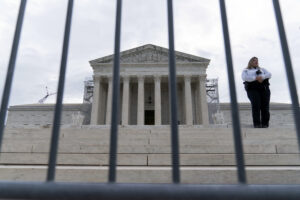Ohio Votes To Enshrine the Right to an Abortion
With 99% of precincts reporting, 56.35% of voters passed the Issue 1 constitutional amendment on Tuesday, protecting reproductive rights in the Buckeye state. Issue 1 supporters cheer as they watch election results come in, Tuesday, Nov. 7, 2023, in Columbus Ohio. (AP Photo/Sue Ogrocki)
Issue 1 supporters cheer as they watch election results come in, Tuesday, Nov. 7, 2023, in Columbus Ohio. (AP Photo/Sue Ogrocki)
Ohio voters passed the Issue 1 constitutional amendment to protect abortion and reproductive rights Tuesday. The Associated Press called the election over Issue 1 shortly after 9 p.m.
With more than 99% of precincts reporting early Wednesday, the amendment was passing with 56.35% of the vote, or 2.14 million voters out of more than 3.8 million who had cast ballots in the race. That result will remain unofficial until provisional ballots are counted and official results are certified.
“Today, Ohioans made it clear, abortion is a winning issue, and together we can do anything,” said Lauren Blauvelt, co-chair of the Ohioans United for Reproductive Rights and executive director of Planned Parenthood Advocates of Ohio.
The amendment, brought by Ohio Physicians for Reproductive Rights, Ohioans for Reproductive Freedom and other reproductive rights advocacy groups, will enshrine abortion, contraception, fertility treatment, miscarriage care, and continuing one’s own pregnancy into the Ohio Constitution.
The measure is similar to the constitutional amendment Michigan voters passed in 2022, Proposal 3.
“Today, Ohioans made it clear, abortion is a winning issue, and together we can do anything.”
Nancy Kramer, co-chair of Ohioans United for Reproductive Rights and one of the individuals who led the constitutional amendment effort, said the amendment was a “citizen-led” effort full of “diverse and dynamic” people.
“We have marshaled the resources, the enthusiasm and now the votes of millions of Ohioans,” Kramer said at a Tuesday night watch party for Issue 1 supporters and the media.
The Issue 1 effort sought to stem attempts by both state and federal officials to regulate abortion through the use of bans and/or limits, and continue a burgeoning trend in the country that saw usual Republican strongholds like Kentucky and Kansas pass abortion rights measures by overwhelming numbers, along with Michigan, California and Vermont. Montana voters rejected an initiative that would have allowed criminal charges for providers who failed to take “reasonable actions” to save a fetus, even after an abortion.
In Ohio, a six-week ban with no exceptions for rape or incest was passed in 2019 and signed by Gov. Mike DeWine. Then it was tied up in court until the U.S. Supreme Court’s decision in Dobbs v. Jackson Women’s Health Organization overturned the national legalization of abortion in Roe v. Wade. That day, Ohio Attorney General Dave Yost moved to get the six-week ban released from its court entanglement, which allowed the ban to be implemented for 82 days in 2022.
Abortion rights groups tried to get the Ohio Supreme Court to intervene, but after weeks of inaction, the groups moved the case to the Hamilton County Court of Common Pleas, where a judge issued a preliminary injunction in the fall of 2022, pausing the ban indefinitely.
The case still has not been resolved, even causing the state to appeal the injunction to the Ohio Supreme Court. The state’s highest court heard arguments about the injunction, but still has not ruled on the appeal. The amendment’s passage will likely provoke further legal action and requests for judgment, though advocates have not yet declared what their next steps will be.
On the amendment’s passage, the organizing director for the ACLU of Ohio, Elizabeth Chasteen Day, said the conservative moniker has been assigned to Ohio, but that didn’t deter voters for Issue 1.
“They like to say we’re conservative, they like to count us out, but what we know about Ohioans is that you can’t count us out,” Chasteen Day said.
“I have a daughter and I really want to make sure that she has more rights than we do, not less rights.”
Hundreds of organizers, campaigners and canvassers attended the election night watch party for Issue 1, gathering to see the election results on TV monitors and join with fellow supporters.
Melinda Dobson attended Tuesday’s election night watch party for the Issue 1 supporters. Her husband works for the ACLU, but she took time to canvass today in Cincinnati before coming up for the event.
She said the issue comes down to the next generation, who she wants to set up for the future.
“I have a daughter and I really want to make sure that she has more rights than we do, not less rights,” Dobson said.
President Joe Biden issued a statement following Issue 1’s passage: “Ohioans and voters across the country rejected attempts by MAGA Republican elected officials to impose extreme abortion bans that put the health and lives of women in jeopardy, force women to travel hundreds of miles for care, and threaten to criminalize doctors and nurses for providing the health care that their patients need and that they are trained to provide.”
The road to Election Day
The summer started off with high hopes for the amendment after signature collectors submitted more than 400 boxes of signatures to the Ohio Secretary of State. Nearly 500,000 of the signatures were verified, indicating a large base of support for the amendment before campaigning had even begun.
The Ohio Ballot Board approved the language of the amendment, but changed the summary language that voters would see on their ballots, to the chagrin of abortion rights advocates, who said changing words like the medically-accepted “fetus” to “unborn child,” among other changes, slanted the summary in a way that misrepresented the amendment itself.
Polling since the amendment was introduced showed majority support for the measure, matching or exceeding public opinion polls from previous years.
The Ohio Supreme Court disagreed for the most part after hearing a challenge to the changes. The court ruled that most of the changes could stay, with the exception of wording that assigned authority to the “citizens of the state of Ohio,” which the state supreme court ordered the ballot board to return to the previous language of “the state of Ohio.”
The amendment avoided another potential hurdle after state Republicans, including Ohio’s Secretary of State Frank LaRose, put their support behind a previous Issue 1 this August, which would have changed the Ohio Constitution by raising the threshold to pass any amendment from 50% to 60%. Ohio voters rejected that amendment with 57% against.
Polling since the amendment was introduced showed majority support for the measure, matching or exceeding public opinion polls from previous years.
Early voting showed the same support for the measure as polls seemed to, with Democratic areas of the state overperforming not only in favor of the abortion amendment, but also for Issue 2, the initiated statute to legalize marijuana.
The opposition reaction
The organization Protect Women Ohio led the effort to defeat Issue 1 while Susan B. Anthony Pro-Life America and Leonard Leo-connected Concord Fund put more than $15 million each into the effort. The “no” campaign was marked by disinformation, with ads that claimed the amendment would undermine parental consent for minors seeking abortions or gender affirming care. Legal experts repeatedly shot down these assertions.
Shortly after the AP called the race, former Ohio Right to Life official Lizzie Marbach released a statement criticizing organizations for not addressing the issue “head on.” Ohio Right To Life parted ways with Marbach earlier this year over her social media use and tone.
Early voting showed the same support for the measure as polls seemed to, with Democratic areas of the state overperforming not only in favor of the abortion amendment, but also for Issue 2, the initiated statute to legalize marijuana.
Marbach insisted anti-abortion groups’ “cowardice during this pivotal moment should not be forgotten moving forward.” She added that the fight will now turn to establishing equal protection for unborn fetuses through The 14th Amendment.
Ohio House Speaker Jason Stephens promised to continue fighting as well.
“As a 100% pro-life conservative, I remain steadfastly committed to protecting life, and that commitment is unwavering,” he wrote in a statement. “The legislature has multiple paths that we will explore to continue to protect innocent life. This is not the end of the conversation.”
Later, Center for Christian Virtue President Aaron Baer spoke to reporters on behalf of Protect Women Ohio. He insisted that “Issue 1 does not represent Ohio values,” and warned the parade of horribles from their campaign ads is right around the corner.
“We stand ready during this unthinkable time to advocate for women and the unborn — just as we have always done,” he said. “We persevered for 50 years to overturn Roe v Wade. Ours is a movement that has always endured and always will. Tomorrow, the work starts again.”
Ohio Capital Journal is part of States Newsroom, a network of news bureaus supported by grants and a coalition of donors as a 501c(3) public charity. Ohio Capital Journal maintains editorial independence. Contact Editor David DeWitt for questions: [email protected]. Follow Ohio Capital Journal on Facebook and Twitter.
Your support matters…Independent journalism is under threat and overshadowed by heavily funded mainstream media.
You can help level the playing field. Become a member.
Your tax-deductible contribution keeps us digging beneath the headlines to give you thought-provoking, investigative reporting and analysis that unearths what's really happening- without compromise.
Give today to support our courageous, independent journalists.






You need to be a supporter to comment.
There are currently no responses to this article.
Be the first to respond.